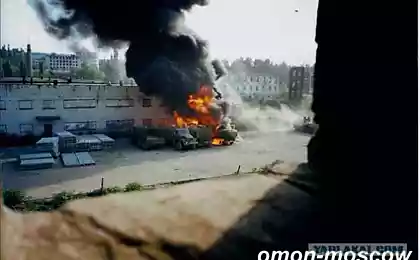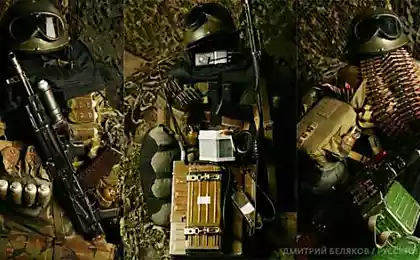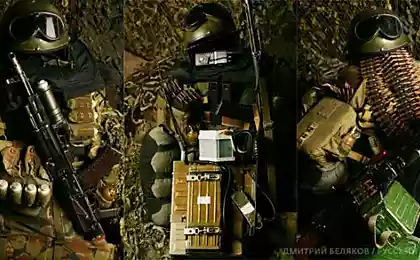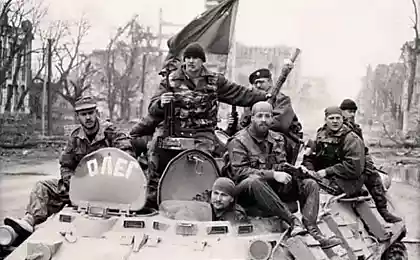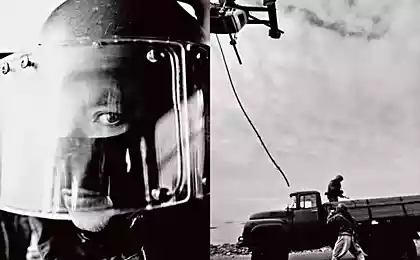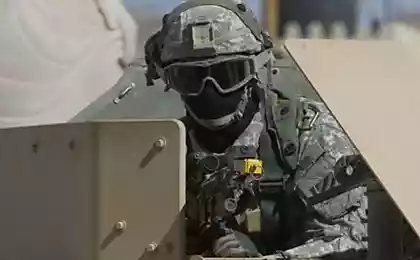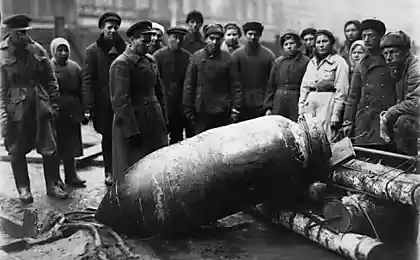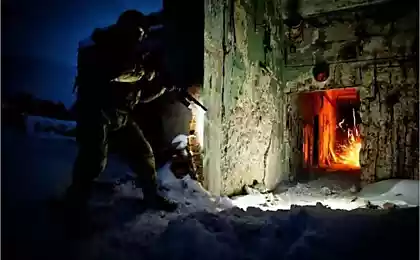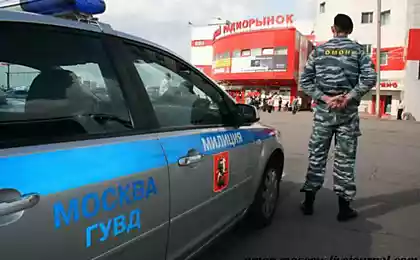1759
Four-legged soldiers
During the Great Patriotic War Dog orderlies bore the battlefield more than 700 thousand wounded soldiers
At the historic Victory Parade on July 24, 1945 were presented to all the Great Patriotic War, all the families of the troops. But not everyone knows that, at the parade followed by composite regiment fronts, shelves Navy and columns of military equipment on Red Square were ... dogs with their conductors.
At the historic parade of the "box" of soldiers with dogs was the main canine country Colonel Mazover. He was allowed to mint not move and do not salute the commander in chief, as he was carrying in his arms a soldier of the 14th Assault field engineer brigade - a dog named Djulbars.
Djulbars found about 7,000 mines and 150 rounds, participated in the clearance of many palaces and cathedrals of Europe. At the end of the war Djulbars was injured and could not participate in the Victory Parade and when notified put Joseph Stalin, the latter ordered the dog to carry on his jacket: "Let the dog will carry on his hands on Red Square on my jacket ...»
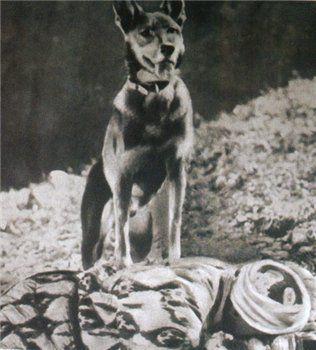
dogs participated in the wars since ancient times. In the fourth century BC, the Chaldeans in the invasion of southern Mesopotamia before the attack wore on their dogs heavy metal collars with sharp curves knives. Fighting dogs, described by historians, have been widely used in Assyria and Babylon, were the hordes of Darius and Xerxes, the troops of the Celts, Huns and Teutons. And in the XIX century dogs began to introduce in the staffing units and the Russian army.
In 1919, scientist canine Vsevolod languages first came to the headquarters of the Red Army with a proposal to organize a service dog school in the Red Army. The following year, the dogs were already in service with the KGB. After another three years across the country began to organize clubs and sections service dog lovers, dog breeders.
Baptism of fire their students passed in 1939. Two special purpose company under the command of Colonel Oleynik were sent to Mongolia and participated in the defeat of the Japanese troops in Khalkhin-Gol.
There's the idea of using dogs to detect Finnish snipers - "cuckoo", which penetrated into the territory of the Soviet troops were hiding in the trees. To perform this task used huskies.
Combat experience in Finland prompted Colonel Medvedev's idea to use four-legged soldiers to detect mines and shells.
The scale military action demanded by the Central Red Army dog school that produced the formation of driving units, a lot of work on completion of their dogs, special equipment, facilities and trained personnel - counselors, nurses.
Great help in the delivery of dogs for the army had a population of our country and especially members of the club service dog Osoaviahima.
Tens of thousands of dogs have been "called" to units of dog sledding.
This military service were taken by German, Caucasian, Central Asian, South Russian Shepherd, Husky, all varieties, hounds, Métis these rocks and mongrel dogs, have the above qualities.
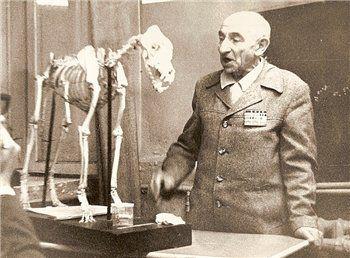
Dogs kamikaze units existed in the Red Army before October 1943. They are believed to have destroyed about three hundred German tanks. But in the battle were killed far more pets fighters. Many of them did not have time even to throw under the tracks and died on the way to the goal. They were shot with machine guns and automatic rifles, they blew up ... even their (the dog with a mine on the back, do not perform the job was dangerous).
More than six thousand dogs were mine detectors. In total, they discovered the ease and counselors-sappers defused four million mines and bombs! Dog-miner cleared Belgrade, Kiev, Odessa, Novgorod, Vitebsk, Polotsk, Warsaw, Prague, Budapest, Berlin.

In the personal file of a gentle collie named Dick says: "conscripted from Leningrad and trained mine detection work. During the war years saw more than 12,000 mines involved in demining Stalingrad Lysychansk, Prague and other cities. Chief Dick feat performed in Pavlovsk ».
It was so. An hour before the explosion, Dick found in the basement of the palace bomb in two and a half tons and clockwork.
After the Great Victory legendary dog, despite multiple injuries, was a multiple winner of dog shows. Veteran dog lived to a ripe old age and was buried with full military honors, as befits a hero.
Member of the Great Patriotic War tyumenets Sergei Solovyov in one of our meetings related how during the battle, he often witnessed the feat four-legged attendants: "Because we are dense fire, sanitation, could not get to the badly wounded fellow soldiers. Wounded needed urgent medical care, many of them bled. Between life and death remained a matter of minutes ... come to the aid of a dog. They crawled on their bellies to the wounded and tripped him side with the medical bag. Patiently waiting for him to bind up the wound. Only then sent to another. They could accurately distinguish the living from the dead man, as many wounded were in a state of unconsciousness. This four-legged soldier medic licking face as long as he did not regain consciousness. In the Arctic winter, harsh, not just from the severe frosts injured rescued dogs - they warmed them with his breath. You may not believe me, but the dogs were crying over the dead ... »
Thanks to the ingenuity and skills of the dog team can act remarkably smoothly, efficiently and proactively. Here's how to describe the work of the "unit" during the lifting of the blockade in 1944 Tamara Ovsyannikova, serving a courier in the 268 th Infantry Division: "I took the coil and ran across the field near the railroad. And suddenly I see: two dogs, and next to the wounded and draggers. Shaggy nurses revolve around the wounded. I dragged them scraper. The dog lay down next to the wounded, and her medical bag on the side - injured his leg bandaged, I helped them to plunge it into scraper, they harnessed and dragged. That's because for the first time saw the dog-techs. It struck me very much. Since dogs have great respect for ... »
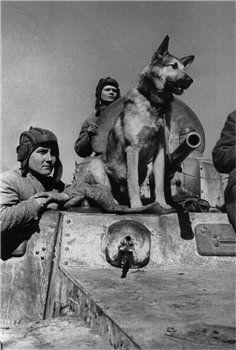
Among the retreating Red Army orders was a separate battalion of Kolomna border detachment, located
250 service dogs. During the protracted battles Major Lopatin was asked to dissolve tailed fighters - Shepherds. They had nothing to feed.
Commander disobeyed orders and left four-legged soldiers in the unit. In the most critical moment of endless German attacks near the village of Legedzino when he felt that he no longer resist ... sent to the attack dogs.
Old residents of the village still remember the heart-rending cries, screams of panic, barking dogs and the roar that sounded neighborhood. Even mortally wounded four-legged soldiers would not let the enemy. Not expecting such a turn, take a back seat and the Germans retreated. Years passed and the grateful descendants May 9, 2003 on the outskirts of the village erected a monument in the border guards and their four-legged assistants.
And this is not an isolated case. From the report of the commander of the 30th Army Lieutenant General Lelyushenko of March 14, 1942 .: "In the period of the defeat of the Germans near Moscow put into attack enemy tanks were put to flight by dogs Fighter battalion. The enemy is afraid of dogs, and especially anti-hunt them ».
During the Great Patriotic War Dog orderlies bore the battlefield more than 700 thousand wounded soldiers! It is worth noting that sanitation for 80 people, made from the battlefield, awarded the title of Hero of the Soviet Union.
Altogether during the hostilities was formed about 15 thousand dogsleds, which brought the wounded soldiers in the shelter where they could provide urgent medical care. And this is perhaps the most important feature of assistance dogs in the rescue of our soldiers.
At the historic Victory Parade on July 24, 1945 were presented to all the Great Patriotic War, all the families of the troops. But not everyone knows that, at the parade followed by composite regiment fronts, shelves Navy and columns of military equipment on Red Square were ... dogs with their conductors.
At the historic parade of the "box" of soldiers with dogs was the main canine country Colonel Mazover. He was allowed to mint not move and do not salute the commander in chief, as he was carrying in his arms a soldier of the 14th Assault field engineer brigade - a dog named Djulbars.
Djulbars found about 7,000 mines and 150 rounds, participated in the clearance of many palaces and cathedrals of Europe. At the end of the war Djulbars was injured and could not participate in the Victory Parade and when notified put Joseph Stalin, the latter ordered the dog to carry on his jacket: "Let the dog will carry on his hands on Red Square on my jacket ...»

dogs participated in the wars since ancient times. In the fourth century BC, the Chaldeans in the invasion of southern Mesopotamia before the attack wore on their dogs heavy metal collars with sharp curves knives. Fighting dogs, described by historians, have been widely used in Assyria and Babylon, were the hordes of Darius and Xerxes, the troops of the Celts, Huns and Teutons. And in the XIX century dogs began to introduce in the staffing units and the Russian army.
In 1919, scientist canine Vsevolod languages first came to the headquarters of the Red Army with a proposal to organize a service dog school in the Red Army. The following year, the dogs were already in service with the KGB. After another three years across the country began to organize clubs and sections service dog lovers, dog breeders.
Baptism of fire their students passed in 1939. Two special purpose company under the command of Colonel Oleynik were sent to Mongolia and participated in the defeat of the Japanese troops in Khalkhin-Gol.
There's the idea of using dogs to detect Finnish snipers - "cuckoo", which penetrated into the territory of the Soviet troops were hiding in the trees. To perform this task used huskies.
Combat experience in Finland prompted Colonel Medvedev's idea to use four-legged soldiers to detect mines and shells.
The scale military action demanded by the Central Red Army dog school that produced the formation of driving units, a lot of work on completion of their dogs, special equipment, facilities and trained personnel - counselors, nurses.
Great help in the delivery of dogs for the army had a population of our country and especially members of the club service dog Osoaviahima.
Tens of thousands of dogs have been "called" to units of dog sledding.
This military service were taken by German, Caucasian, Central Asian, South Russian Shepherd, Husky, all varieties, hounds, Métis these rocks and mongrel dogs, have the above qualities.

Dogs kamikaze units existed in the Red Army before October 1943. They are believed to have destroyed about three hundred German tanks. But in the battle were killed far more pets fighters. Many of them did not have time even to throw under the tracks and died on the way to the goal. They were shot with machine guns and automatic rifles, they blew up ... even their (the dog with a mine on the back, do not perform the job was dangerous).
More than six thousand dogs were mine detectors. In total, they discovered the ease and counselors-sappers defused four million mines and bombs! Dog-miner cleared Belgrade, Kiev, Odessa, Novgorod, Vitebsk, Polotsk, Warsaw, Prague, Budapest, Berlin.

In the personal file of a gentle collie named Dick says: "conscripted from Leningrad and trained mine detection work. During the war years saw more than 12,000 mines involved in demining Stalingrad Lysychansk, Prague and other cities. Chief Dick feat performed in Pavlovsk ».
It was so. An hour before the explosion, Dick found in the basement of the palace bomb in two and a half tons and clockwork.
After the Great Victory legendary dog, despite multiple injuries, was a multiple winner of dog shows. Veteran dog lived to a ripe old age and was buried with full military honors, as befits a hero.
Member of the Great Patriotic War tyumenets Sergei Solovyov in one of our meetings related how during the battle, he often witnessed the feat four-legged attendants: "Because we are dense fire, sanitation, could not get to the badly wounded fellow soldiers. Wounded needed urgent medical care, many of them bled. Between life and death remained a matter of minutes ... come to the aid of a dog. They crawled on their bellies to the wounded and tripped him side with the medical bag. Patiently waiting for him to bind up the wound. Only then sent to another. They could accurately distinguish the living from the dead man, as many wounded were in a state of unconsciousness. This four-legged soldier medic licking face as long as he did not regain consciousness. In the Arctic winter, harsh, not just from the severe frosts injured rescued dogs - they warmed them with his breath. You may not believe me, but the dogs were crying over the dead ... »
Thanks to the ingenuity and skills of the dog team can act remarkably smoothly, efficiently and proactively. Here's how to describe the work of the "unit" during the lifting of the blockade in 1944 Tamara Ovsyannikova, serving a courier in the 268 th Infantry Division: "I took the coil and ran across the field near the railroad. And suddenly I see: two dogs, and next to the wounded and draggers. Shaggy nurses revolve around the wounded. I dragged them scraper. The dog lay down next to the wounded, and her medical bag on the side - injured his leg bandaged, I helped them to plunge it into scraper, they harnessed and dragged. That's because for the first time saw the dog-techs. It struck me very much. Since dogs have great respect for ... »

Among the retreating Red Army orders was a separate battalion of Kolomna border detachment, located
250 service dogs. During the protracted battles Major Lopatin was asked to dissolve tailed fighters - Shepherds. They had nothing to feed.
Commander disobeyed orders and left four-legged soldiers in the unit. In the most critical moment of endless German attacks near the village of Legedzino when he felt that he no longer resist ... sent to the attack dogs.
Old residents of the village still remember the heart-rending cries, screams of panic, barking dogs and the roar that sounded neighborhood. Even mortally wounded four-legged soldiers would not let the enemy. Not expecting such a turn, take a back seat and the Germans retreated. Years passed and the grateful descendants May 9, 2003 on the outskirts of the village erected a monument in the border guards and their four-legged assistants.
And this is not an isolated case. From the report of the commander of the 30th Army Lieutenant General Lelyushenko of March 14, 1942 .: "In the period of the defeat of the Germans near Moscow put into attack enemy tanks were put to flight by dogs Fighter battalion. The enemy is afraid of dogs, and especially anti-hunt them ».
During the Great Patriotic War Dog orderlies bore the battlefield more than 700 thousand wounded soldiers! It is worth noting that sanitation for 80 people, made from the battlefield, awarded the title of Hero of the Soviet Union.
Altogether during the hostilities was formed about 15 thousand dogsleds, which brought the wounded soldiers in the shelter where they could provide urgent medical care. And this is perhaps the most important feature of assistance dogs in the rescue of our soldiers.

